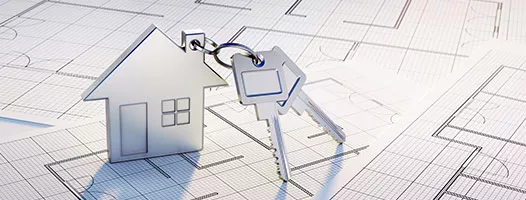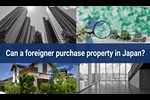Standard Land Price for Tokyo in 2021 - Decline for the first time in 9 years in the commercial areas

On September 21st, the Ministry of Land, Infrastructure, Transport and Tourism announced the standard land prices for their selected points nationwide. On the same day, the Tokyo Metropolitan Government also announced the land prices of their selected locations in Tokyo. The standard land price (*later explained in more detail) refers to the price of land per 1 square meter for selected locations as of the 1st of July each year.
The average rate of land price fluctuation for all usages in Tokyo has increased by 0.1% from last year (2020). While this year marks the 9th consecutive year that the land price has increased, the increase in the land price when compared with the previous year, is significantly lower than that of the 0.6% rise from 2019 to 2020.
For Commercial Areas, the average price fluctuation rate has decreased by 0.3%, which is decline for the first time in 9 years. Due to the influence of the coronavirus pandemic, the food and beverage industry and tourism industry have been facing very severe situations. This has in turn affected Tokyo’s major commercial areas such as Ginza and Shinjuku, which have accounted for some of the highest declines in land price rates.
Commercial Area
The average land price in Tokyo has declined by 0.3% from 2020, which has turned negative from the rate increase of 1.3% (from 2019) in 2020. This year’s average price fluctuation, within the 23 wards of Tokyo, from 2020 is -0.3%, which has also turned negative from the 1.8% increase (from 2019) in 2020.
The rate of decline in “5 wards in Central Tokyo” stands out among all the land price declines within Tokyo, falling by 1.3% on average. Decline ranking of the 23 wards has shown that Chuo-ku had the largest decline by 1.9%, while Shinjuku-ku marked the 2nd largest fall by 1.8% and Chiyoda-ku marked the 3rd largest fall by 1.2%. In the top 5 decline ranking of the land points (within the 23 wards), the land points in Ginza, Chuo-ku have occupied the 2nd and 3rd largest decline rates, and the 3 land points in Shinjuku-ku occupied the 4th and 5th largest decline rates including 1st largest decline rate in the Kabukicho area.
Under these circumstances, however, some of the price rises were found in some land points with the trend of finishing shopping near own homes due to self-restraint of going out. The land point in Ikegami 6-chome, Ota-ku (increased by 3.3% from 2020) , where the demand has increased after the opening of the commercial building at Ikegami Station in March, has occupied the 1st largest increase rate within the 23 wards, and the land point in Nakano 5-chome, Nakano-ku (increased by 2.7% from 2020), where the redevelopment around the north exit of JR Nakano Station is boosting the demand, has resulted in the 2nd largest increase rate.
The highest price point in Japan—remaining unchanged for 16 consecutive years—is the Meijiya Ginza Building at 2-6-7, Ginza, Chuo-ku. The price, 39,500,000yen per square meter (41,000,000yen in 2020) has decreased by 3.7%, which is the second consecutive year of negative fluctuation.
Residential Area
The average price increase within Tokyo is 0.2%, which is unchanged from the previous year (2020). While the price has increased in all 23 wards, it can be seen that the rate of increase in the average price for all wards has dropped from 1.4% (in 2020) to 0.5%. The highest increase in price for residential areas within 23 wards this year was 1.9% in Shinagawa-ku, followed by 1.8% in Minato-ku and Taito-ku.
In the 23 wards, the land point in Ariake 1-chome, Koto-ku, which has risen by 3.4%, has been ranked as the largest rate of increase. In August 2020, demand increased with the opening of the commercial facility named “Ariake Garden”. The land point in Shibaura 4-chome, Minato-ku near Takanawa Gateway Station, which opened in March 2020, has also risen by 2.6%. As for the ranking of the falling land points, all the top 10 largest declining rates have been marked in the land points in Setagaya-ku, which are the residential areas far from the train station, including the land point in Okamoto 3-chome, Setagaya-ku (-2.0%), which has been ranked 1st place.
Land Prices (Nationwide)
One noteworthy point about this year’s standard land prices (as of July 1st) announced by the Ministry of Land, Infrastructure and Transport, is that the national land price average for all types of land usage have shown a decline of 0.4% (from 2020), which is the second consecutive year of negative fluctuation.
What stands out among all the results is the “crustal movement” of land prices that are advancing under the 2nd year of the new coronavirus disasters. Looking carefully at the land points where the land prices have risen amid a nationwide decline, what can be seen are some driving forces that are working on the land prices, such as the inflow of overseas money and people’s reevaluation on their living environment due to frequent works from home.
In the three major metropolitan areas, the Tokyo area has remained positive fluctuation by 0.1% increase in commercial areas, while the Osaka area, which has turned negative for the first time in 9 years, has fallen by 0.6%. In the background there is the money supply for investment through quantitative monetary easing that has flooded around the world where the investment markets are mostly not active due to the new coronavirus disasters, and the Tokyo area is attracting such investment money. The recent trend shows that overseas money is flowing into the office building market in central Tokyo, where overseas investors are targeting at excellent building properties that were sold by the companies that have deteriorated in earnings due to the new coronavirus disasters. Such office buildings in central Tokyo are attractive for the investors because stable yields can be expected. Looking at the rising land points of residential areas, people are reevaluating their living environment due to their frequent telecommuting and self-restraint of going out, and such mind-set increases the demands of the land points. In Tokyo, the land point in Musashino City, where Kichijoji is frequently ranked high as “City you want to live in”, has risen by 1.5%. In the Tokyo area, the price rises are noticeable in Urayasu City, Chiba Prefecture (increase by 2.4%) and in Kanagawa-ku in the center of Yokohama City (increase by 1.6%).
It is expected that expansion of teleworking will not easily turn back even after the new coronavirus disasters go away, and with such an increase in teleworking time, for choosing homes people are more likely to take into account the charm of the city or the area where they live beyond their commuting time.
Ranking by Top 5 Price Increase points and Decrease points(23 Wards)
Kabukicho and Ginza fall in Commercial Areas
| Address Points | Price(1000Yen/㎡) | Fluctuation(%) | |
|---|---|---|---|
| ▼Address of Price Rise Points | |||
| Commercial Area | ➀ 6-3-8, Ikegami, Ota-ku | 1,020 | 3.3 |
| ➁ 5-64-9, Nakano, Nakano-ku | 4,880 | 2.7 | |
| ➂ 40-22, Senju Asahicho, Adachi-ku | 1,340 | 2.3 | |
| ➃ 2-17-10, Sangenchaya, Setagaya-ku | 1,930 | 2.1 | |
| ➄ 3-70-2, Senju, Adachi-ku | 1,460 | 2.1 | |
| ▼Address of Price Down Points | |||
| 商業地 | ➀ 1-18-9, Kabukicho, Shinjuku-ku | 6,970 | -10.1 |
| ➁ 7-3-14, Ginza, Chuo-ku | 6,140 | -9.0 | |
| ➂ 6-8-3, Ginza, Chuo-ku | 28,500 | -7.2 | |
| ➃ 3-18-5, Shinjuku, Shinjuku-ku | 16,000 | -7.0 | |
| ➄ 2-6-1, Nishishinjuku, Shinjuku-ku | 12,700 | -3.8 | |
| ▼Address of Price Rise Points | |||
| 住宅地 | ➀ 1-3-7, Ariake, Koto-ku | 695 | 3.4 |
| ➁ 1-14-11, Akasaka, Minato-ku | 4,870 | 3.2 | |
| ➂ 3-32-7, Takada, Toshima-ku | 843 | 2.8 | |
| ➃ 1-1-5, Ueno Sakuragi, Taito-ku | 853 | 2.8 | |
| ➄ 5-9-28, Kitashinagawa, Shinagawa-ku | 1,160 | 2.7 | |
(Source for data: Tokyo Metropolitan Government Bureau of Finance *Round off to one decimal place)
* Reference source: Nihon Keizai Shimbun dated September 22, 2021
*What is the Standard Land Price?
The standard land price is the price of land per 1 square meter and is calculated for each selected point of land as of the 1st of July each year. The Prefectural Governments are responsible for its survey and the Ministry of Land, Infrastructure, Transport and Tourism release the nationwide results. It is one of the two major representative data that shows the fluctuation of land price along with the official land price that is announced on Jan.1 every year.
While the official land price mainly covers the area within the city planning area, the standard land price includes residential land, commercial land, industrial land, and forest land that is not residential land outside the city planning area.
>> Real Estate Pricing in Japan - 6 different land prices

- Rental Apartments & Houses in Tokyo
- Listings of popular and luxurious rental apartments, condominiums, and houses designed with expats in mind.

- Apartments & Houses for Sale in Tokyo
- Listings of apartments, condominiums, and houses available for purchase in Tokyo.





















